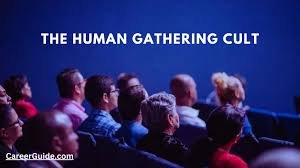Human Gathering Cult: Exploring the Myths and Realities

Introduction
The term human gathering cult evokes curiosity and speculation, often associated with secretive groups, mysterious practices, and controversial ideologies. These organizations, whether real or perceived, have sparked debates about their nature, influence, and intentions. Are they simply misunderstood communities, or do they hold deeper, more ominous secrets? In this article, we delve into the intricacies of “human gathering cult” to uncover the truth and dispel misconceptions.
Understanding the Concept of a Human Gathering Cult
The idea of a “human gathering cult” often revolves around groups that assemble for spiritual, social, or ideological purposes. These gatherings may range from harmless and well-intentioned to manipulative and exploitative. Common characteristics of such groups include:
- Unified Belief System: Members of a “human gathering cult” often adhere to a shared philosophy or worldview, which can be spiritual, political, or cultural.
- Charismatic Leadership: Many such groups are led by a figure who commands authority and devotion, shaping the group’s activities and ideology.
- Exclusive Membership: Membership is typically selective, creating a sense of belonging while isolating members from external influences.
Origins and History of Human Gathering Cults
The phenomenon of “human gathering cult” is not new. Throughout history, societies have witnessed the emergence of groups that gather for specific purposes. Some notable examples include:
- Ancient Mystery Cults: In ancient civilizations such as Greece and Rome, mystery cults conducted secretive rituals to honor deities like Dionysus or Mithras.
- Religious Movements: Over the centuries, religious gatherings have sometimes been labeled as cults due to their unconventional beliefs or practices.
- Modern-Day Groups: In the 20th and 21st centuries, organizations like the People’s Temple or Heaven’s Gate gained notoriety as “human gathering cult” examples due to their controversial activities.
Characteristics of a Human Gathering Cult

To better understand what defines a human gathering cult it’s essential to explore its distinguishing traits:
Secrecy and Mystique
Many groups operate under a veil of secrecy, which fuels speculation and often leads to their classification as a “human gathering cult”. This secrecy can serve various purposes:
- Protecting members from societal judgment.
- Preserving the sanctity of their rituals and teachings.
- Controlling the narrative about the group.
Psychological Influence
A significant aspect of a “human gathering cult” is its ability to influence members’ thoughts and behaviors. Techniques used may include:
- Love Bombing: Showering new members with affection to create a sense of belonging.
- Isolation: Encouraging members to distance themselves from non-believers or critics.
- Fear Tactics: Instilling fear about leaving the group or questioning its teachings.
Rituals and Symbolism
Rituals are central to many “human gathering cult” practices. These rituals can be symbolic, spiritual, or communal, serving to reinforce group identity and loyalty.
Why Do People Join a Human Gathering Cult?
Understanding the motivations behind joining a “human gathering cult” is crucial to demystifying these groups. Common reasons include:
- Search for Meaning: Many individuals are drawn to cults while seeking purpose or answers to existential questions.
- Desire for Community: The promise of a close-knit community can attract those who feel isolated or disconnected.
- Charismatic Leadership: The allure of a compelling leader often plays a significant role in recruitment.
Famous Examples of Human Gathering Cults
The People’s Temple
Led by Jim Jones, the People’s Temple became infamous for the Jonestown tragedy in 1978. This “human gathering cult” initially promoted social justice but later descended into manipulation and tragedy.
Heaven’s Gate
Founded by Marshall Applewhite and Bonnie Nettles, Heaven’s Gate was a UFO-based “human gathering cult” that ended in a mass suicide in 1997.
The Rajneesh Movement
This spiritual movement, led by Bhagwan Shree Rajneesh (Osho), faced allegations of manipulation, exploitation, and even bioterrorism, earning its classification as a “human gathering cult” by critics.
The Psychological Impact of Being in a Human Gathering Cult
Joining a “human gathering cult” can profoundly affect an individual’s mental and emotional well-being. Positive effects might include a sense of belonging or purpose, while negative impacts can range from emotional dependency to severe trauma.
Cognitive Dissonance
Members often experience cognitive dissonance when their beliefs conflict with the reality of the group’s actions. This internal struggle can lead to:
- Increased loyalty as a coping mechanism.
- Withdrawal from external perspectives to avoid discomfort.
Post-Cult Recovery
Leaving a “human gathering cult” can be challenging, as former members may struggle with identity, trust, and reintegration into society. Support groups and therapy often play a vital role in recovery.
Legal and Ethical Implications
The activities of a “human gathering cult” can sometimes cross legal and ethical boundaries, raising concerns about their legitimacy and societal impact. Common issues include:
- Exploitation: Some groups exploit members financially, emotionally, or physically.
- Freedom of Belief: Balancing the right to religious or ideological freedom with societal protection is a complex issue.
- Accountability: Holding leaders accountable for manipulative or harmful practices remains a significant challenge.
Debunking Myths About Human Gathering Cults

While the term “human gathering cult” often carries negative connotations, not all such groups are harmful. It’s essential to differentiate between legitimate communities and exploitative organizations.
Myth: All Cults Are Dangerous
Reality: While some cults engage in harmful practices, others function as supportive communities for their members.
Myth: Members Are Brainwashed
Reality: Many individuals willingly join a “human gathering cult”, driven by personal beliefs or desires.
Recognizing Warning Signs of a Human Gathering Cult
To protect oneself from potential harm, it’s important to recognize red flags associated with a “human gathering cult”:
- Excessive control over members’ lives.
- Pressure to cut ties with family or friends.
- Unquestioning devotion to a leader or ideology.
Societal Perception of Human Gathering Cults
Public perception of a “human gathering cult” is often shaped by media portrayals, which tend to sensationalize these groups. This has led to:
- Stereotypes that stigmatize legitimate communities.
- Fear and mistrust of unconventional organizations.
- A lack of nuanced understanding of diverse groups.
How to Approach the Subject of a Human Gathering Cult
Discussing the topic of a “human gathering cult” requires sensitivity and an open mind. Key approaches include:
- Avoiding judgment or bias.
- Encouraging critical thinking and informed decision-making.
- Offering support to those affected by such groups.
Also read Authority Magazine Telehealth Best Practices
Conclusion
The concept of a “human gathering cult” is multifaceted, encompassing a wide range of groups with varying intentions and practices. By exploring the myths, realities, and impacts of these organizations, we can better understand their role in society. Whether viewed as a source of community or controversy, “human gathering cult” remains a topic that warrants further exploration and thoughtful dialogue.







